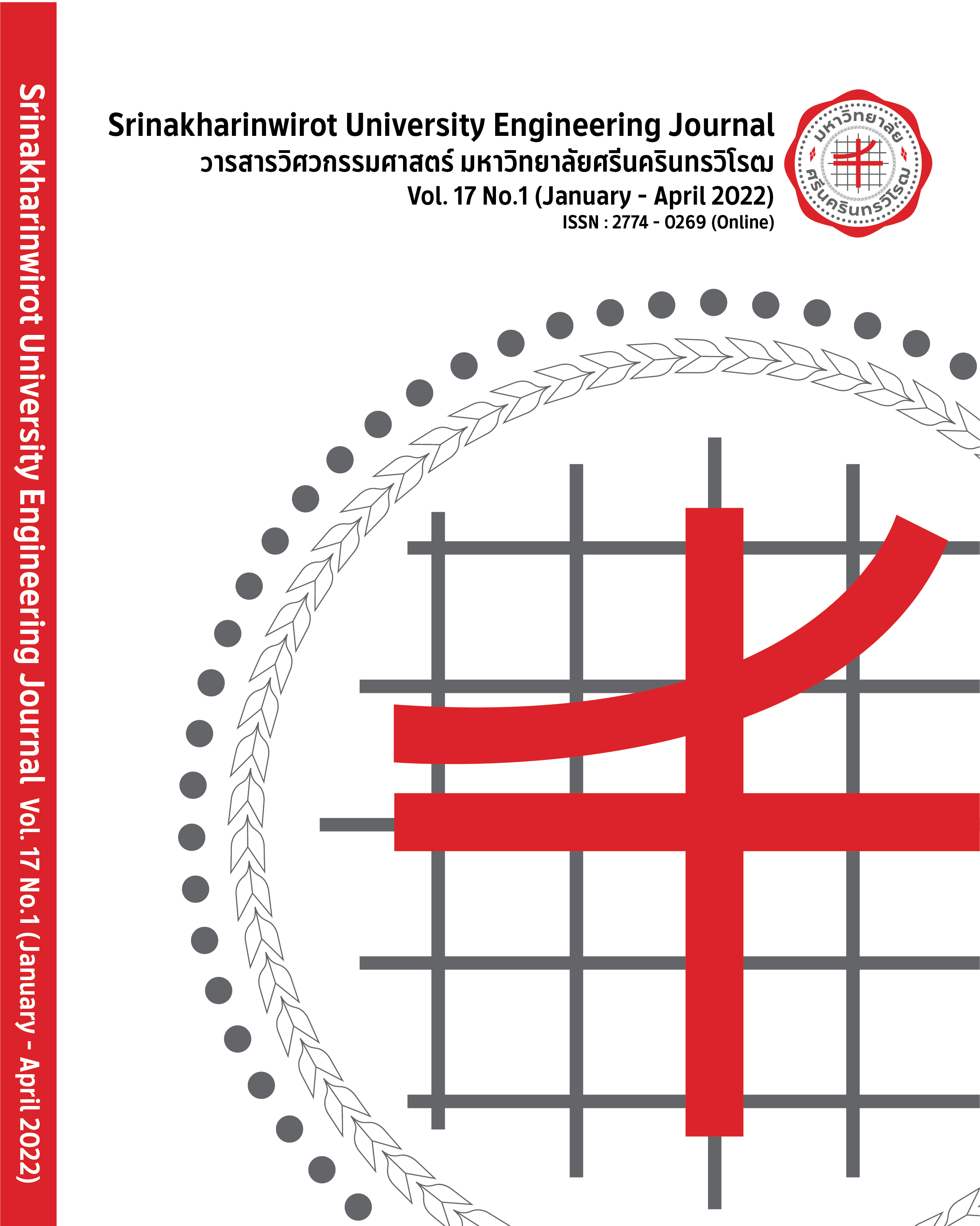The Study of Paddy Drying in Zig Zag Pipe Spouted Bed Dryer
Main Article Content
Abstract
The objective of this research was studied on the drying potentiality of paddy in Zig - zag piped spouted bed dryer. The prototype of the dryer was designed and fabricated in the modern concept which can rapidly dry according to the enforcement of paddy flow in the test section. This technique is used to provide the extended drying period and well mixing of paddy and hot air in the dryer which affected in reducing the drying time and increasing in energy consumption efficiency in the dryer. The 4 kg Khao Dawk Mali 105 rice specie paddy is testing material mixing. Using the 80°C, 100°C and 120°C hot air as the working fluid at the air velocity of 16 m·s-1. Two type of the 90° elbow test section (8 and 16 turning elbow) are used in this experiment. The experimental results show that at high air temperature 16 turning elbow pipe performs higher drying rate and consumes lower primary specific energy (SECHeater) than 8 turning elbow pipe. While 8 turning elbow pipe gives lower secondary specific energy (SECBlower) than 16 turning elbow pipe. The lower hot air temperature required the more activated energy in evaporating the moisture of paddy grain than higher hot air temperature. Likewise, 8 turning elbow test section yields more activated energy than 16 turning elbow test section. As the activated energy of 43.78 to 170.74 kJ·mol-1 were used in this experiment.
Article Details

This work is licensed under a Creative Commons Attribution-NonCommercial-NoDerivatives 4.0 International License.
Copyright belongs to Srinakharinwirot University Engineering Journal
References
Department of Agriculture, Quality and Inspection of Thai Hom Mali Rice. Bangkok, Thailand: Jirawat express co., ltd., 2004.
T. Chitsomboon, S. Khaengkarn and K. Pechnumkheaw, “Free-fall-paddy rice dryer: A fast and energy efficient dryer,” in The 2nd Conference on Energy Network of Thailand, 2006.
K. Pechnumkheaw, S. Meesukchaosumran and T. Chitsomboon, “Effect of Air Velocity on Drying Rate of Paddy Using Continuous Free-fall Technique,” in The 22nd Conference on Mechanical Engineering Network of Thailand, 2008.
C. Nimmol, “Energy Efficiency of Paddy Dehydration Process using Pneumatic Dryer with Spiral-pipe Drying Column,” KKU Research Journal, vol. 17, no. 1, pp. 97-109, 2012.
K. Jaito, N. Prangpru, T. Treeamnuk, J. Jokkew, K. Treeeamnuk and T. Chuenatsadongkot, “Paddy Drying with Circulating Pneumatic Dryer,” in The 19th TSAE National Conferences, Kasetsart University, Thailand, 2018.
S. Sritunyakorn, K. Suluksna and T. Chitsomboon, “Effect of Drying Air Temperature on Paddy Drying Using Spouted Free Fall Bed Dryer,” in The 34th Conference on Mechanical Engineering Network of Thailand, 2020.
N. Wongbubpa, K. Treeamnuk and T. Treeamnuk, “Kinematics motion of paddy in hot air pulse flow,” in The 13th TSAE International Conferences, Suranaree University of Technology, Thailand, 2020.
N. Wongbubpa, T. Yabsungnoen, K. Treeamnuk, T. Treeamnuk and P. Prakotmak, “Computer Simulation Study of Paddy Motion in Hot Air Drying Chamber,” in The 22nd TSAE National Conferences, Khon Kaen University, Thailand, 2021.
S. Soponronnarit, Drying Grains and Some Types of Foods. 7th ed. Bangkok, Thailand: KMITT, 1997.
N. Wongbubpa, “Operating Cures of The Elbowed Spouted Bed Paddy Dryer,” M.S. Thesis, Mechanical Engineering, Suranaree University of Technology, pp. 93-97, 2014.
T.M. Afzal and T. Abe, “Diffusion in potato during far infrared radiation drying,” Journal of food engineering, vol. 37, no. 4, pp. 353-365, 1998.
J. Crank, The Mathematics of Diffusion. 2nd ed. Oxford: Clarendon Press, 1975, pp. 47-53.
Er. R.K. Rajput, Heat and Mass Transfer. India: S. Chand & Company ltd, 2000.


